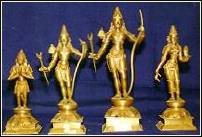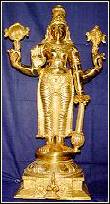SCULPTURES
METAL SCULPTURES
Metal sculptures became
popular throughout India during the post-Gupta period. In South India,
they mastered the art of making huge exquisite sculptures with great stress
on designs and details. The art achieved its zenith in the Chola period.
The Cholas were Saivites and hence they mostly cast idols of Siva ( Nataraja
), other Saiva Gods such as Muruga, Sakthi, Ganesha, Saivite Saints. They
also erected and renovated Vaishnavite shrines. Idols of Vishnu, Lakshmi
in various aspects were also cast. The utsava murthis (idols) of temples,
which are taken out in procession during temple festivals were made of
bronze and panchaloha.
All of these idols were
cast based on rules, proportions and methods laid down in the ancient texts
based on scientific principles. The artisans who were involved in this
art are called the Sthapathis.
Basically, the metal
sculptures were cast using wax models. Two methods are followed, one yielding
solid figures and the other hollow images.
In one process, a wax
model of deity (or any figure) is made. Over this wax model, a clay mould
is made. After the clay around the wax is dried, the wax within the clay
mould is heated for the wax to melt and molten metal poured into the clay
mould. Once the metal is cooled and set, the outer mould is broken. The
image thus created is of rough finish and lots of work will go into polishing
and finishing the resulting solid sculpture.
In the second process,
a clay model is first made, which is coated with an even layer of wax,
strictly following the form of the figure. On top of this wax layer, fine
clay is applied in thin layers in stages till a thick outer coat of clay
is formed. Now there is a wax layer in between two layers of clay. Once
the clay is dried, the mould is heated till the wax melts. Molten metal
is poured into the gap between the two layers. The clay layers are removed
to yield a hollow metal sculpture.
     
Photographs
: courtesy Sri Giri Trading Agency
|